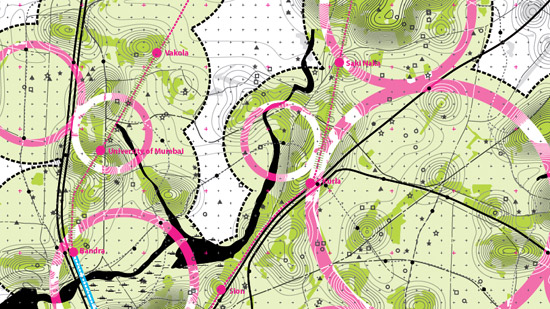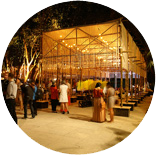Heart of Mumbai (Design Project)

The Heart of Mumbai design project spearheaded by Neville Mars aims to forge connections between large-scale and local infrastructures, between North and South Mumbai, and between formal and informal areas. The project seeks to achieve a fully connected urban network, the hallmark of a more equal and more efficient city—one based on access to resources and public space, where public infrastructure benefits more communities. Heart of Mumbai engages the city on levels ranging from suggesting how Mumbai’s informal settlements can become more sustainable to planning how to streamline its future transit system. The main emphasis, however, is on the intermediate scale of pedestrian infrastructure.
Most people in Mumbai walk as a means of transportation: less than 2 percent of the city’s population travels by private car. But, as in many cities, transportation investments are not dispersed in similar proportions. The Heart of Mumbai envisions skywalks, which have produced fast and tangible results in Mumbai over the past few years, as one way to correct this imbalance. The project presents varied pedestrian solutions, from simple alterations to sophisticated systems developed in collaboration with local communities, demonstrating that public skywalks can be even more socially vibrant, sustainably savvy, and revenue-generating.
To find out where skywalks would be most effective, the Heart of Mumbai compares detailed density maps with existing transit lines. Potential bridges are evaluated not only as crossings, but as tools of strategic planning. With densities shifting north, the project’s map reveals a new hub at the geographic center of Mumbai emerging on the fault lines of old and new Mumbai, a crossroads of extreme density and diversity that has the potential to relieve the gridlock of the historic city. Here, pedestrian bridges become a tool to integrate informal settlements, which are still devoid of most public infrastructure, with the larger city. Networked together, the different neighborhoods can share their resources, tap into new markets, and embrace sustainable solutions at an appropriate scale.
Photo: courtesy Neville Mars
This work was created by Neville Mars in connection with the BMW Guggenheim Lab project, a project of the Solomon R. Guggenheim Foundation, and is licensed under a Creative Commons Attribution 3.0 Unported License.

